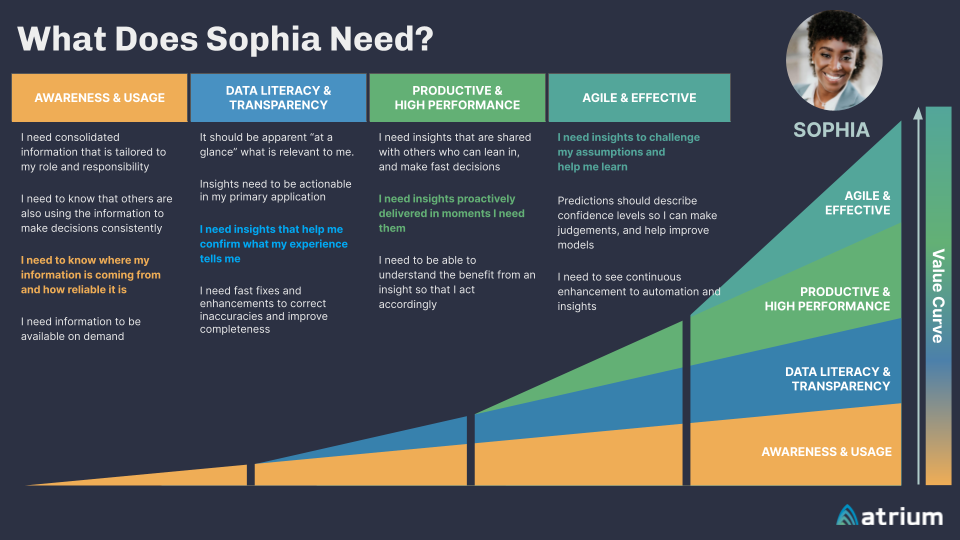Creating a data-driven culture is essential for companies to stay competitive. By leveraging data to inform decision-making, companies can gain a significant advantage over their competitors by improving operational efficiency, and driving growth. However, building a data-driven culture is not a simple task, and requires a concerted effort from all levels of the organization.
Even if you have a modern BI architecture in place, a common problem we find is that adoption lags (i.e., no one is showing up to make use of your investment in BI modernization). To help achieve long-term success, here we’ll discuss the seven steps large companies should take to ensure adoption and build a data-driven culture.
Step 1: Define the vision and strategy
The first step in building a data-driven culture is to define the vision and strategy. This includes identifying the specific business goals the company hopes to achieve, such as improving customer experience, reducing costs, or increasing revenue. Once the company defines their goals they should develop a clear strategy for how they will use data to achieve these goals. The company should communicate these goals to all employees, so they understand the importance of data and how it fits into the business strategy.

Step 2: Assign ownership and accountability
Creating a data-driven culture also requires assigning ownership and accountability for data. This should involve identifying the key data sources, determining how data will be collected, stored, analyzed, and used, and establishing clear roles and responsibilities for data management. It is also important to define the metrics that will be used to measure performance and success. This will help ensure that data is being used effectively and that the company is productively leveraging its data assets. Additionally, by assigning ownership and accountability, the company can ensure that data is being used in a compliant and ethical manner.
Step 3: Invest in the right technology aligned with a holistic data strategy
To build a data-driven culture, companies not only need the right technology but they also need a holistic data vision and strategy as well. This includes data storage, analysis, and visualization tools, as well as the infrastructure to support these tools. By investing in the right technology — be it Salesforce, Tableau, Snowflake, or the optimization and smarter integration of those data platforms — companies can ensure that data is accessible and can be analyzed quickly, which is essential for making data-driven decisions.
Additionally, by investing in technology that allows for the sharing of data across the organization, companies can foster collaboration and increase the number of people who can use data to make decisions.
Step 4: Create a data governance framework
Creating a data governance framework is critical for building a data-driven culture. A data governance framework details the rules and procedures that govern the collection, storage, use, and dissemination of data. Companies should design this framework to ensure that data is accurate, secure, and compliant with all relevant laws and regulations. Additionally, the framework should include policies for data quality, data security, and data retention.
Step 5: Provide training and support data literacy
To encourage adoption for your modern bi architecture, companies need to provide training that enhances data literacy. This includes providing training on data management best practices, data analysis techniques, and data visualization tools. Companies should also create opportunities for employees to work with data. They can help employees gain experience and build skills through data science projects or data-focused teams.
To sustain data literacy learning long term, companies should provide ongoing support to employees to help them access and use the data they need to be effective in their areas of expertise, according to the company’s data management framework. This will ensure that employees are equipped to make data-driven decisions and that they understand how data fits into the business strategy.

Step 6: Encourage data-driven decision making
Next, companies must encourage data-driven decision-making. This also means data should be used to measure the success of business initiatives. Companies can bolster their data literacy success by establishing a culture of experimentation and continuous improvement, where employees use data to test hypotheses and inform decisions. Managers should all reinforce these practices by recognizing and rewarding employees for making data-driven decisions.
Step 7: Measure and track progress
Finally, companies should measure and track progress in building a data-driven culture. This includes tracking key metrics, such as data quality, data usage, and data-driven decision-making. Companies should also conduct regular assessments to understand where they are succeeding and where they are struggling to use data.
Ultimately, building a data-driven culture requires a concerted effort from all levels of the organization. By investing time in the steps above, companies can fully leverage their data to drive business success and get their teams on the same date-centric page in the process.
Reach out and let’s discuss your business goals and how to get there with business change enablement focused on BI modernization. In the meantime, learn more about our BI modernization expertise:







